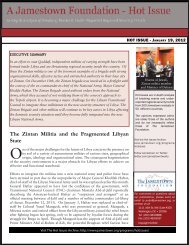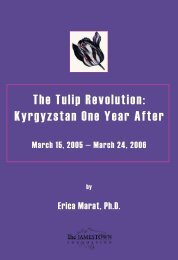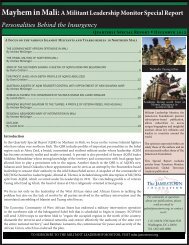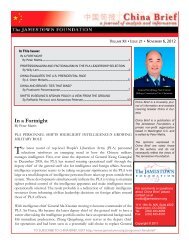By Brian Glyn Williams - The Jamestown Foundation
By Brian Glyn Williams - The Jamestown Foundation
By Brian Glyn Williams - The Jamestown Foundation
You also want an ePaper? Increase the reach of your titles
YUMPU automatically turns print PDFs into web optimized ePapers that Google loves.
BACKGROUND<br />
In order to fully understand the alliance between the Crimean Tatars and the Ottoman Turks, one must first<br />
look back to the Crimean Khanate's predecessor, the Golden Horde. <strong>The</strong> Golden Horde, which was<br />
formed by Genghis Khan's grandson Batu encompassed much of what is today Russia and Ukraine,<br />
including the Crimean Peninsula in the south. In the centuries following Batu's death, the Crimea became a<br />
haven for unsuccessful aspirants to the Horde's throne.<br />
<strong>By</strong> 1443, one of these contenders, Haci Giray, had succeeded in breaking away from the Golden Horde and<br />
establishing himself as independent ruler over parts of the Crimea and the adjacent areas of the steppe. His<br />
family was to rule over the Crimea with few exceptions until the end of the eighteenth century.<br />
One of Islam's greatest successes over Christianity, the Ottoman conquest of Constantinople in 1453 by<br />
Mehemed the Conqueror, occurred ten years after the establishment of the Khanate and undoubtedly<br />
caught the attention of the Crimean Tatars who began to look to the Ottomans for assistance in their<br />
struggles with the Khans of the Golden Horde. With Constantinople's fall, a fellow Turkic Muslim<br />
power was in control of the Dardenelles and Bosphorous.<br />
One of the Sultan's first actions upon gaining control of the entrance to the Black Sea, was to move against the<br />
Genoese trading posts on the southern coast of the Crimea. In the summer of 1454, an Ottoman fleet of 56<br />
vessels entered the Black Sea to begin the process of enforcing Mehemed II ’ s rule in an area that would eventually<br />
be known as the “Ottoman Lake.”<br />
Haci Giray Khan led a troop of 7,000 Tatars to assist the Ottomans in an unsuccessful siege of Kaffa, the largest of<br />
the Italian coastal trading centers. 1 Although this joint military adventure did not result in any major<br />
conquests for either of the participants, it set the precedent for future collaboration between the two<br />
states. For the next ten years Haci Giray and Mehemed devoted their attention to more immediate concerns<br />
and the two powers remained relatively distant.<br />
<strong>The</strong> Ottoman Empire did not involve itself in the Crimea again until 1466. In that year, Haci Giray died<br />
under mysterious circumstances, possibly poisoned by Tatar clan leaders who were jealous of his<br />
growing power. 2 After his death, two of his sons, Nurdevlet and Mengli, began a struggle for the throne.<br />
During the course of this civil war the Crimean clans grew to play an increasingly important role.<br />
In 1475, the head of the powerful Shirin clan, Eminek, invited the Ottoman Sultan Mehemed II to intervene in<br />
the civil war. Mehemed II was easily convinced of the benefits to be incurred from interference in the<br />
Crimea. He saw it as an opportunity to gain influence among the Tatars, as well as a chance to strike a<br />
blow at the Kaffans who were also involved in the dispute.<br />
On May 19, 1475, an Ottoman fleet left for the Crimea to intervene in the struggle for the throne and<br />
conquer the Italian trading cities of the peninsula. Two weeks later, the Ottoman commander, Mehemed<br />
Pasha, once again assembled the famed Turkish cannon before the walls of Kaffa and commenced a second<br />
siege of the city. <strong>The</strong> Kaffans resisted the intense Ottoman bombardment for only four days before<br />
unconditionally surrendering to the Sultan's forces.<br />
<strong>The</strong> Kaffans suffered heavily for their resistance to the Ottomans, and most of the Italian population was<br />
2
















